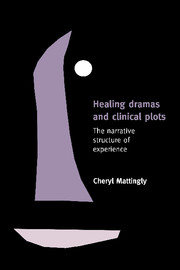Book contents
- Frontmatter
- Contents
- Preface
- Acknowledgments
- 1 Finding narrative in clinical practice
- 2 The mimetic question
- 3 The checkers game: clinical actions in quest of a narrative
- 4 Therapeutic plots
- 5 The self in narrative suspense: therapeutic plots and life stories
- 6 Some moments are more narrative than others
- 7 Therapeutic plots, healing rituals, and the creation of significant experience
- Notes
- References
- Index
1 - Finding narrative in clinical practice
Published online by Cambridge University Press: 05 June 2012
- Frontmatter
- Contents
- Preface
- Acknowledgments
- 1 Finding narrative in clinical practice
- 2 The mimetic question
- 3 The checkers game: clinical actions in quest of a narrative
- 4 Therapeutic plots
- 5 The self in narrative suspense: therapeutic plots and life stories
- 6 Some moments are more narrative than others
- 7 Therapeutic plots, healing rituals, and the creation of significant experience
- Notes
- References
- Index
Summary
Attention to human suffering means attention to stories, for the ill and their healers have many stories to tell. Serious illness takes people from ordinary to extraordinary. Trying to understand those with severe illness may be rather like, as Sacks says, making “house calls at the far borders of human experience” (Sacks 1995: xx). The stories of the very sick and disabled comprise a “literature of extreme situations” (Broyard 1992: 41) The need to narrate the strange experience of illness is part of the very human need to be understood by others, to be in communication even if from the margins. This book considers the relation between narrative and that essential human experience – devastating, life-altering illness. Illness, especially chronic illness or severe disability, reveals much about how a culture conceives life in time, being as a kind of becoming marked by transitions, transformations and the inexorable progress toward death. There is more than one kind of death possible, of course. Serious disability may allow you to live for years and years, for an entire span of life, and yet force a death of self and the painful recreation of some new self. Narrative plays a variety of roles in this grim terrain.
Narrative constitutes a mode of thought and representation especially suited to considering life in time, shifting temporal shapes, and the human path of becoming where death is never far away.
- Type
- Chapter
- Information
- Healing Dramas and Clinical PlotsThe Narrative Structure of Experience, pp. 1 - 24Publisher: Cambridge University PressPrint publication year: 1998
- 2
- Cited by



